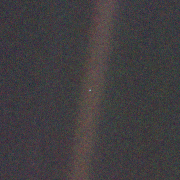from the Big Bang?
Did you ever play the game “Six Degrees of Separation from Kevin Bacon”, where you try to find six links between you and the actor (or some other famous person or event)? It’s always interesting to see how many legitimate links you can find. For example, I have one degree of separation from walking on the Moon if I count the times I’ve met Apollo astronauts over the years. Or, taking it in another direction, I am two degrees from meeting the president of the United States through one of my relatives. If I think about it long enough, I can probably find links to other famous (or even everyday) people throughout the world due to my work with planetariums and science centers or through the people who have bought my books.

But, what’s my link to the Big Bang? To the Big Kahuna event that started the expansion of space and time and the evolution of “stuff” that we know of today? Well, aside from the fact that I (and you and everything we know about is part of the universe), it’s kind of fun to simplify it down according to the rules of the game.
For this iteration, let’s look at the materials that make up our bodies–the basic elements.
At that level, I’m one link away (and so are you). How so? We all have hydrogen in our bodies, and that’s the most abundant element in the universe and the first one created in the Big Bang. So we go from Big Bang where all the hydrogen was created.
Of course, it’s not a straight-line “transmission” of hydrogen. In other words, we don’t go from hydrogen to humans in one fell swoop. There have to be some intermediate steps. So, we look inside stars, which first formed a few hundred million years after the Big Bang. Atoms of hydrogen gas inside those stars were heated to tremendously high temperatures and fused to create helium and carbon and oxygen. And, of course, we have carbon in our bodies and we breathe a mixture of oxygen and other gases to stay alive. So, the action of nuclear furnaces early in the history of the cosmos function at two and possibly three degrees of separation between us and the Big Bang.
But, you still don’t have a straight line from the Big Bang to life. There are some additional transformative events that give us more degrees of separation from the Big Bang. What are they? In the process of stardeath, new elements are created and spread out to interstellar space. Over time, they combine to create new stars and eventually planets. Earth came about as a result of the deaths of other stars and the subsequent formation of the Sun–which was NOT formed right after the Big Bang, but was born from a mixture of interstellar hydrogen and elements ejected from older stars that WERE formed right after the Big Bang. This makes the Sun a Population l star, as opposed to the first-generation stars which are the so-called Population III stars, and the stars that followed them, which are called Population II.
Somewhere in that complex mixing of old material and new stuff, the chemical complexity was enough to spur the formation of places where life could exist, and where, indeed, life began and evolved. How many degrees of separation is THAT from the Big Bang? Astonishingly, it’s probably only five generations from Big Bang to Life. First, you start with Big Bang and hydrogen. Secondly, you go to the first populations of stars, which created heavier elements and then died and spread their “stuff” out to the cosmos. Thirdly, you see new generations of stars being born out of a mix of second-generation stuff and first-generation hydrogen. Then, fourthly, you see at least one (and probably more) planets arise with the ability to support the chemical mixing that encourages the formation of life. That’s four degrees. Take it two steps further: the evolution of life at degree five, and then on to step six: the evolution of intelligent life forms (who contains elements from earlier links in the chain in their bodies) and who are smart enough to ponder these questions.
Of course, it’s all more complex than what I’ve just described — but remember, I’ve used the skeleton of the Six Degrees Game to construct the separations. You could make it 12 or 200 or 735 or 6,000, and at each level, you’d find astonishing degrees of complexity. It’s almost like a Mandelbrot fractal…
You might think that I’m leading up to the idea that the universe evolved so that intelligent life could come about to ponder such questions. Nope. Not a chance. It’s just one way of seeing how interconnected everything in the universe is, and what some of those connections are.

